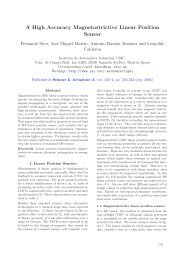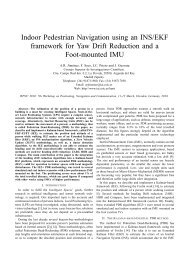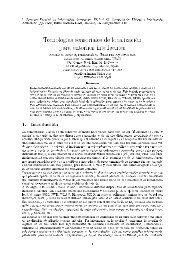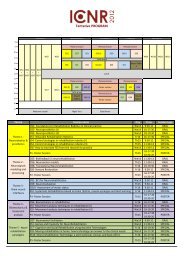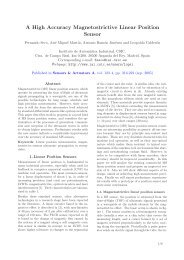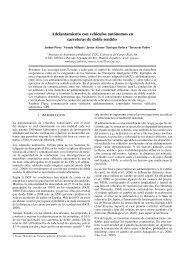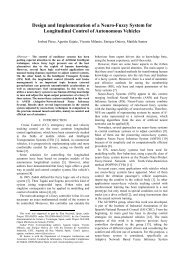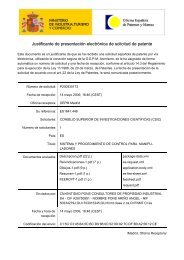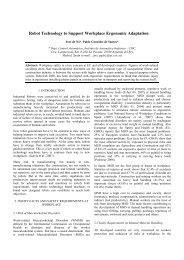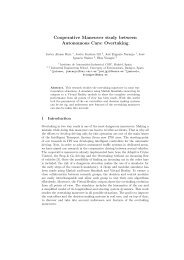Full paper Minimizing Energy Consumption in Hexapod Robots
Full paper Minimizing Energy Consumption in Hexapod Robots
Full paper Minimizing Energy Consumption in Hexapod Robots
You also want an ePaper? Increase the reach of your titles
YUMPU automatically turns print PDFs into web optimized ePapers that Google loves.
P. Gonzalez de Santos et al. / Advanced Robotics 23 (2009) 681–704 7017. M. F. Silva, J. A. Tenreiro Machado and A. M. Endes Lopes, <strong>Energy</strong> analysis of multi-leggedlocomotion systems, <strong>in</strong>: Proc. 4th Conf. on Climb<strong>in</strong>g and Walk<strong>in</strong>g <strong>Robots</strong>, Karlsruhe, pp. 143–150(2001).8. T. Zel<strong>in</strong>ska, Efficiency analysis <strong>in</strong> the design of walk<strong>in</strong>g mach<strong>in</strong>es, J. Theor. Appl. Mech. 38,693–708 (2000).9. V. V. Zhoga, Computation of walk<strong>in</strong>g robots movement energy expenditure, <strong>in</strong>: Proc. IEEE Int.Conf. on Robotics and Automation, Leuven, pp. 163–168 (1998).10. J. E. Bares and D. S. Wettergreen, Dante II: technical description, results and lesson learned, Int.J. Robotics Res. 18, 621–649 (1999).11. J. Bares and W. Whittaker, Configuration of autonomous walkers for extreme terra<strong>in</strong>, Int. J. RoboticsRes. 12, 535–559 (1993).12. Nomad: Lunar Rover Navigation, http://www.cs.cmu.edu/∼lri/nav97.html (1997).13. C. Ye and J. Borenste<strong>in</strong>, A new terra<strong>in</strong> mapp<strong>in</strong>g method for mobile robot obstacle negotiation, <strong>in</strong>:Proc. UGV Technology Conf. at the 2003 SPIE AeroSense Symp., San Jose, CA, pp. 2561–2562(2003).14. P. Pfaff and W. Burgard, An efficient extension of elevation maps for outdoor terra<strong>in</strong> mapp<strong>in</strong>g, <strong>in</strong>:Proc. 5th Int. Conf. on Field and Service Robotics, Port Douglas, QLD, pp. 165–176 (2005).15. P. Gonzalez de Santos, J. A. Cobano, E. Garcia, J. Estremera and M. A. Armada, A six-leggedrobot-based system for humanitarian dem<strong>in</strong><strong>in</strong>g missions, Mechatronics 17, 417–430 (2007).16. SILO-6 website, http://www.iai.csic.es/users/silo617. S. M. Song and K. J. Waldron, Mach<strong>in</strong>es that Walk: the Adaptive Suspension Vehicle. MIT Press,Cambridge, MA (1989).18. M. Kaneko, S. Tachi, K. Tanie and M. Abe, Basic study on similarity <strong>in</strong> walk<strong>in</strong>g mach<strong>in</strong>es from apo<strong>in</strong>t of energetic efficiency, IEEE J. Robotics Automat. 3, 19–30 (1987).19. J. Nishii, K. Ogawa and R. Suzuki, The optimal gait pattern <strong>in</strong> hexapods based on energetic efficiency,<strong>in</strong>: Proc. 3rd Int. Symp. on Artificial Life and Robotics, Beppu, Vol. 1, pp. 106–109 (1998).20. S. Ma, Time optimal control of manipulators with limit heat characteristics of actuator, Adv. Robotics16, 309–324 (2002).21. P. Gonzalez de Santos, E. Garcia and J. Estremera, Improv<strong>in</strong>g walk<strong>in</strong>g-robot performances byoptimiz<strong>in</strong>g leg distribution, Autonomous <strong>Robots</strong> 23, 247–258 (2007).22. W. Y. Jiang, A. M. Liu and D. Howard, Foot-force distribution <strong>in</strong> legged robots, <strong>in</strong>: Proc. 4th Int.Conf. on Climb<strong>in</strong>g and Walk<strong>in</strong>g <strong>Robots</strong>, Karlsruhe, pp. 331–338 (2001).23. P. Gonzalez de Santos, J. Estremera and E. Garcia, Optimiz<strong>in</strong>g leg distribution around the body <strong>in</strong>walk<strong>in</strong>g robots, <strong>in</strong>: Proc. IEEE Int. Conf. on Robotics and Automation, Barcelona, pp. 3218–3223(2005).24. R. Kurame, K. Yoneda and S. Hirose, Feedforward and feedback trot gait control for quadrupedwalk<strong>in</strong>g vehicle, Autonomous <strong>Robots</strong> 12, 157–172 (2002).25. J. C. Lagarias, J. A. Reeds, M. H. Wright and P. E. Wright, Convergence properties of the Nelder–Mead simplex method <strong>in</strong> low dimensions, SIAM J. Optimizat. 9, 112–147 (1998).AppendixThis Appendix presents the leg k<strong>in</strong>ematics used for simulation and control purposes(Fig. A.1). The direct k<strong>in</strong>ematic relationships consist <strong>in</strong> envision<strong>in</strong>g the position(x i ,y i ,z i ) T of foot i as a function of the jo<strong>in</strong>t components (θ i1 ,θ i2 ,θ i3 ) T :(x i ,y i ,z i ) T = T DIR (θ i1 ,θ i2 ,θ i3 ), (A.1)




